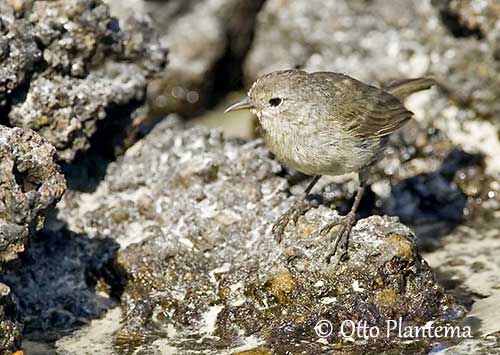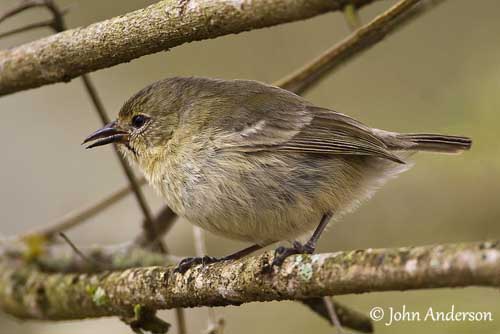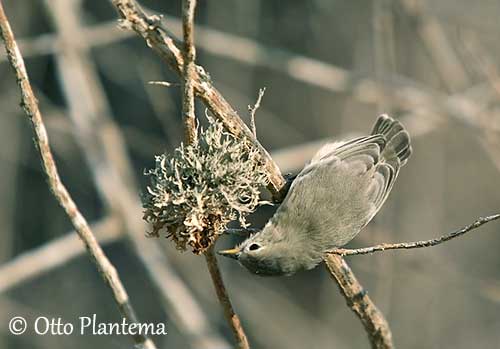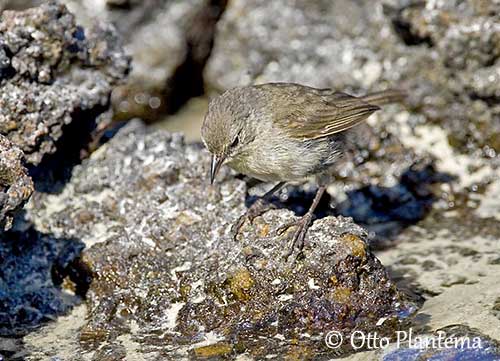
Fr: Géospize gris
All: Blindloedarwinfink
Esp: Pinzón de Darwin Gris
Nd: Grijze Boszangervink
Photographers:
John Anderson
John Anderson Photo Galleries
Otto Plantema
Trips around the world
Text by Nicole Bouglouan
Sources:
HANDBOOK OF THE BIRDS OF THE WORLD Vol 16 by Josep del Hoyo- Andrew Elliot-David Christie – Lynx Edicions – ISBN: 9788496553781
BirdLife International (BirdLife International)
Neotropical Birds – Cornell Lab of Ornithology
Grey Warbler-Finch
Certhidea fusca
Passeriformes Order – Thraupidae Family
Darwin’s Finches - Generalities
INTRODUCTION:
The Grey Warbler-Finch was formerly considered the same species that the Green Warbler-Finch, both members of the genus Certhidea. But several differences such as range, habitat, appearance and song make them two distinct species.
This one has much thinner bill than other Darwin’s Finches. It is endemic to the Galapagos Islands.
DESCRIPTION OF THE BIRD:
Biometrics:
Length: 10 cm
Weight: 8 g
The adult has sandy-grey head and upperparts. We can see narrow pale wingbars on the upperwing, with the lower one more conspicuous than the other. The tail is short and weak.
The underparts are white, with pale dusky tinge on breast and flanks, but the lower flanks are mostly washed buff.
On the head, the long, pointed, Parulid-like bill is blackish during the breeding season, becoming dull orange-yellow with dark culmen outside this period. The eyes are dark brown. Legs and feet are blackish.
Both sexes are similar, and the juvenile resembles adults.

SUBSPECIES AND RANGE:
There are seven subspecies.
C.f. becki is found on Darwin and Wolf Is, in extreme NW Galapagos. This race is larger and darker than nominate, with pale buff to rufescent throat and olive-grey flanks.
C.f. fusca (here described) occurs on Pinta and Marchena in N Galapagos Is.
C.f. mentalis is found on Genovesa in N Galapagos Is.
C.f. bifasciata occurs on Santa Fe in C Galapagos Is. This is the palest race, very pale above and below, mainly whitish on the underparts.
C.f. ridgwayi occurs on Florena in S Galapagos Is. The male shows cinnamon tinge on throat, whereas the female is paler than nominate.
C.f. luteola is found on San Cristobal in SE Galapagos Is. This race shows warmer colours and has yellowish underparts.
C.f. cinerascens occurs on Española (Hood) in SE Galapagos. This one is slightly larger and paler than nominate.
HABITAT:
The Grey Warbler-Finch is found on the smaller drier islands, in arid lowlands. Its natural habitats are tropical and subtropical dry forests and dry shrubland.
CALLS AND SONGS: SOUNDS BY XENO-CANTO
The Grey Warbler-Finch’s song is a repeated series of notes “chip-pi’pi’pi’pi’pi” similar to a slow trill. But the song may vary according to the bill size, with high trill rate from small-billed species.
The subspecies “mentalis” gives more buzzy notes, whereas the nominate race “fusca” lacks these buzzy sounds, and its song is least varied. The bird sings from perches.

BEHAVIOUR IN THE WILD:
The Grey Warbler-Finch has thin bill, well adapted to small insects and spiders constituting its main food. The juveniles are fed exclusively on arthropods.
It forages alone or in pairs, and occasionally in mixed flocks with other finches.
It usually forages at all levels, but mainly in middle storey and rarely on the ground. However, it can be seen sometimes foraging on dry sand beaches along and close to the vegetation. It probes in moss, bark and leaves to find insects and spiders.

The courtship displays are poorly known, but we can suggest that some aerial displays are performed by the male and accompanied by songs. Some races may use ritualized postures to enhance the throat colours.
They are mainly monogamous, and the male is territorial, especially during the egg laying period. The pair maintains a small territory.
The Grey Warbler-Finch is resident in its range.
As non-migratory species, it only performs short-distance flights. It has rounded wings like most resident birds.
REPRODUCTION OF THIS SPECIES:
The breeding season occurs from January to May, and usually starts soon after the first rains on Genovesa.
The male builds the nest alone, a spherical structure with lateral entrance towards the top. This nest is made with dry grasses and other plant materials.
The female lays 4 whitish eggs with darker spots. She incubates during 10-14 days, while the male guards her and defends the small territory. Only females have an incubating patch. She is probably fed by her mate during this period.
Both parents feed the chicks. They fledge 13-15 days after hatching.
This species produces 2-3 clutches within the season.
PROTECTION / THREATS / STATUS:
The chicks are preyed upon by the Short-eared Owl while the adults are taken by the Galapagos Hawk and the Lava Heron.
The Grey Warbler-Finch is vulnerable to habitat destruction and increasing human activities on these islands.
However, the Grey Warbler-Finch has stable populations, and it is common in its range. The species is not currently threatened.
